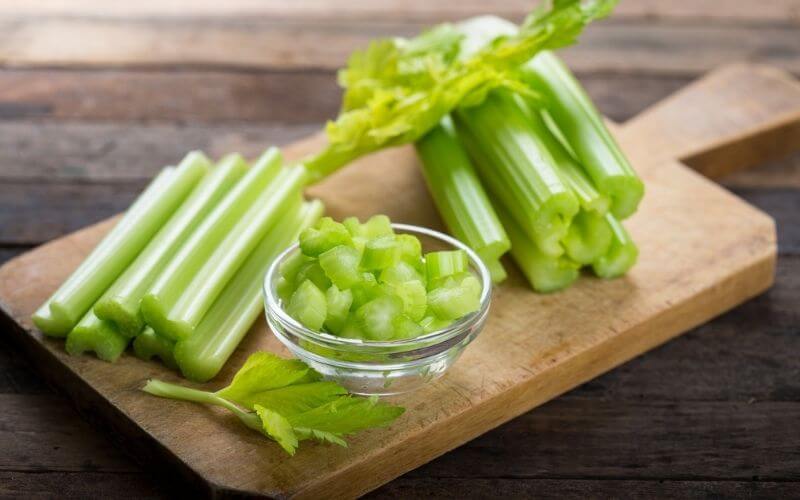Celery is just one of those vegetables that no one ever buys in bulk. It’s more of a supporting character in dishes, as opposed to the star of the show.
Because of this, there’s a good chance that you have a good deal of leftover celery stalks after making a big batch of soup or setting up a relish tray for guests.
But what are you supposed to do with extra celery stalks? Throwing them out is wasteful and I haven’t met anyone who likes munching on celery as a fun snack just to get them out of the way.
This brings us to the question: can you freeze celery? How to keep celery fresh for longer?
I’ll answer these questions, and any other celery adjacent questions you might have right here. We’ll look at the best way to store celery for maximum freshness, the best tips on how to freeze celery, and what you can do with your frozen celery.
Aromatics and stalks are always rather tricky when it comes to long-term storage. Questions like can you freeze carrots and celery? Or, can you freeze leeks?
They are pretty commonplace questions, so this article aims to clear the mystery surrounding frozen celery.
So, with all that out of the way let’s dissect the mystery of this aromatic veggie.
You may also like: How long can you freeze salsa
Celery 101: The Ultimate Healthy Snack
Celery is a stalk with leaves and has been consumed by people since antiquity. It is well-known for its high fiber and water content, which makes it a healthy vegetable for people on diets or trying to eat better.
Celery is considered an aromatic and is the prime ingredient of mirepoix─ a base of aromatics used in soups made by sautéing diced celery, carrots, and onions. The high content of water makes celery a crispy, crunchy stalk that is often served as an appetizer with relish, sour cream, or Greek yogurt as a dip.
What to do with celery leaves? Can you eat celery leaves? Celery leaves are often added to salads, used as a herb like parsley or coriander, minced and used as a garnish or topping, and sometimes included in green smoothies or shakes.
Celery is extremely healthy because it also contains plenty of antioxidants, and is rich in vitamins and minerals. At the same time, it aids in digestion, reduces inflammation, and has just 10 calories per stalk! Having a stash of celery seems like a good idea indeed.
How long is celery good for? When wrapped tightly in aluminum foil or cling film, celery will stay fresh in the drawer of your fridge for up to 2 weeks.
However, it will become drier over time and lose crispness. For longer-term celery storage, you need to keep it in the freezer.
Freezing Celery: How to Store Celery in Freezer

All this leads to the issue: can celery be frozen? Can you freeze fresh celery?
Freezing celery is definitely doable but there is a method to the process. The following steps mentioned will show you the best way to store celery in a way that retains both flavor and freshness.
Preparing Your Celery Stalks:
Before you get to freezing your celery, you need to prep the celery tops. This will ensure a longer freezing time, and keep your celery tasting fresh when added to a dish.
- Separate the celery stalks. Use a small knife to split any attached stalks, trim off the root area at the bottom, and remove any leaves.
- Cut off any coarse stringy bits, as well as discolored sections of the celery stalks.
- Thoroughly wash the stalks and make sure there is no visible dirt on them. Soil tends to cling to the stalks, so you may need to rub them with a scrubber or your fingers.
- Chop celery into the size needed. Some recipes call for thin julienne slices of celery, while others need roughly diced pieces. On the other hand, many recipes need minced celery. This video will show you how to dice celery like a pro.
Blanch the Celery:
Blanching celery is an optional step, but it helps keep the celery crisp and fresh while frozen. It also increases its freezer life. Fresh celery lasts just 2 months in the freezer, while blanched celery lasts for up to a year.
- To blanch celery, boil water in a large pot. Once the water is boiling, add your celery and simmer for around 2-3 minutes. This is enough time to kill any microbes that can cause the celery to go bad.
- Then, strain out the water and tip the blanched celery pieces into a bowl of cold water with ice cubes. This will ‘shock’ the celery and stop them from being cooked any further.
- Once the celery is cool to touch, pat them dry with several sheets of kitchen towels.
Freeze the Celery:
This happens in two stages: first, the celery is flash-frozen, and then kept in the freezer for longer-term storage.
- To flash freeze the celery, lay them out in a single layer on a sheet tray. Place the tray in the freezer for a couple of hours and let wait for the pieces to freeze solid. This step prevents the pieces of celery from sticking to each other and makes using them later much easier.
- Next, take the frozen pieces of celery and place them in a Ziploc bag or ice cube trays. Putting them in ice cube trays makes it easier to remove specific portions when cooking. You can de-mold the cubes and store them in a container or freezer bag for more convenient storage.
- Make sure that you push out the air from your Ziploc or freezer bags to avoid freezer burn. This will also leave more space in your freezer for additional storage.
Using Frozen Celery in Cooking:
After celery is frozen, it loses a good deal of its crispness. Because of this, you can’t serve it up as an appetizer with dip, or add it to salads. In short, it’s a good idea not to use frozen celery raw.
Instead, cook it down in stews and similar recipes like braised celery and mirepoix for the best results. (Can you freeze mirepoix? Yes, but it will be rather mushy.) For the ideal flavor and texture, experts recommend cooking celery that has been frozen.
Tips for Freezing and Cooking with Celery

These handy hacks will help you choose the best celery and freeze them the right way, which in turn will make your dishes taste much better.
- Buy celery stalks that are firm and upright. They should snap when pulled, not bend.
- Fresh celery will have crisp leaves that are green in color. Avoid the ones with wilted brown or yellow leaves.
- You can also steam the celery before freezing them as this will also help preserve flavor.
- When using frozen celery, don’t wait for them to thaw out, as this takes time. Add the frozen celery right into the pot, and any excess water releases will be cooked off.
- For the best flavor and texture, eat your celery within 7 days of purchase, or store it in the freezer.
Celery Recipes for When You’re Bored of the Usual Stuff

As I said, celery is usually added to amp up other ingredients in recipes, or as a lousy snack. Why not try a recipe where celery is the star?
Crab Tostada:
This scrummy lunch features a crunchy tostada that is topped with a crab salad. The salad features things like creamy avocado slices, crisp minced celery, cherry tomatoes, and crab meat sauteed in butter. It is also a good appetizer if you plan on serving frozen steaks or roasts.
Classic Stuffing:
If you’re one of those people who prefer stuffing to turkey, this Thanksgiving staple is meant for you. Crusty rustic-style or even homemade bread, fennel, and celery are the prime ingredients of this recipe and are complemented by the addition of herbs like sage, thyme, parsley, and rosemary.
Celery Kombu:
Say goodbye to the sad sour cream-and-celery stick combo, this will be your new favorite appetizer. Celery stalks are sliced and the strings are removed. They are then smothered in a mix of furikake, sesame oil, soy sauce, and toasted sesame oil.
This light and flavorful starter is ideal if you are planning on serving something heavier like a brisket or monkfish as a main dish.
Khoresh-e Karafs (Celery Stew):
This Persian stew features celery as the main ingredient. It can be prepped with beef or cremini mushrooms, so you can alter it to fit a vegetarian diet.
These 2 ingredients are stewed with aromatics like garlic and onion and seasoned with peppers, dried chili flakes, black pepper, dried mint, and parsley. Fresh lime juice and saffron take this humble stew to a whole new luxurious level.
Scallops on Pureed Celery:
For a simple yet elegant dish, sear some scallops and serve them on a blanket of pureed celery. The celery adds a fresh and green dimension to the meaty scallops. Add shavings of truffles to elevate the dish to a 5-star level.
Still Got Questions?
Below you will find answers to questions people often have about freezing and storing celery.
01. Should I Freeze Whole or Diced Celery?
People often wonder: can you freeze chopped celery? The answer is yes, and it is the best way to store frozen celery and it can be difficult to cut up a whole stalk once it has been frozen.
02. How Long Does Celery Last in the Fridge?
When wrapped carefully and stored in the vegetable crisper, celery lasts up to 2 weeks in the fridge.
03. Why Do I Need to Blanch Celery before Freezing?
Blanching kills any bacteria on the celery which speeds up the process of decomposition. It also helps the celery retain color, texture, and flavor once frozen.
04. Do I Need to Blanch Carrots before Freezing Them?
Like celery, carrots need to be cleaned, diced, and blanched before being frozen. The process of freezing them is exactly the same as that of celery.
05. Can I Freeze Cooked Celery?
Celery-based stews, braised celery, and soups can all be frozen in freezer-safe containers for a couple of months.
Final Say
Knowing how to preserve celery will mean that you always have a fresh veggie on hand to use as a base in soups, stews, and even certain curries.
Next time you have a handful of celery stalks you don’t need right away; you won’t have to ask yourself can you freeze celery?
Instead, bust out the ice cube trays and freezer bags and get ready to blanch and dice a whole lot of celery for future meals!






